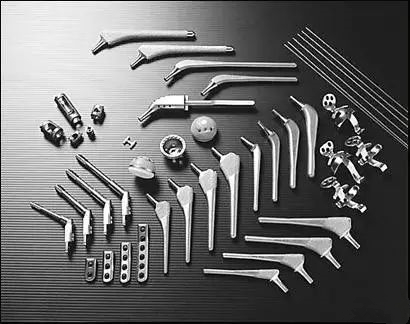
With the advancement of society and economic growth, medical treatment has achieved significant progress. In recent years, the medical goods materials for the treatment, repair of human tissue has played a role. The metal titanium and titanium alloy is extremely frequently employed.
Titanium has a negative passivation potential of -1.63 V, making it a thermodynamically unstable metal. Consequently, it is simple to create an oxide coating with passivation capabilities in air and aqueous solutions and has a high resistance to corrosion.
Corrosion Resistance of Titanium in Different Media
Corrosion Mechanism of Titanium
1. Stress Corrosion
Titanium is a transition element in group IVB.It is chemically active and has a strong affinity for oxygen. In any oxygen-containing media, the surface of titanium tends to generate a dense passivation coating that is exceedingly thin , generally a few nanometres to a few tens of nanometres in thickness. A passivation coating on titanium alloys minimizes the area of surface active dissolving and slows the rate of dissolution, hence reducing dissolution damage. Furthermore, the passivation layer is self-healing. When destroyed, a new protective coating forms fast. As a result, titanium is resistant to corrosion.Pitting corrosion, stress corrosion, crevice corrosion, galvanic corrosion, and wear corrosion are the several types of corrosion that may occur when titanium metal is implanted in living organisms.
SCC occurs in titanium alloys as a result of three variables – environment, stress, and material – and is extremely selective.If any of the three factors is modified, SCC will not occur.
1) Environment
- Media
SCC may occur in a range of media, including numerous aqueous solutions, distilled water, organic solutions, and hot salts. The mechanism of SCC differs depending on the medium. - pH
There is dispute over the impact of pH on SCC in titanium alloys. In general, the SCC sensitivity of titanium alloys reduces as the pH rises, frequently blocking SCC at a pH of 13-14. However, even severe corrosive conditions with a pH of 2-3 can exist in the front portion, where localized SCC cracking changes occur. - Potential
The impact of potential on the degree of SCC is critical. The SCC sensitivity potential varies depending on the metals and media used in the corrosion system. SCC is worsened in aqueous solutions containing halides, for example, when the potential is about -600mV. At overpassivation potentials, cracks form. But at potentials below -1000mV, no cracks appear. The SCC sensitivity potential zone of Ti8Al1Mo1V in aqueous solutions containing Cl- and Br- is -500mV-600mV, but in aqueous solutions containing I-, the sensitive potential zone is above 0mV. - Temperature
Temperature is one of the most influential variables on the formation of SCCin titanium alloys. In general, SCC sensitivity increases as the temperature rises. In a high salt-air environment between 300 and 500 degrees Celsius, Ti6Al3Mo2Zr0.5Sn alloy is more susceptible to stress corrosion above 450 degrees Celsius. At 200°C, Ti6Al4V alloys containing a certain quantity of Pd or Mo in a solution of H2S + CO2 + NaCl + S are less susceptible to SCC than at 250°C. However, materials implanted in the human body have limited temperature sensitivity. - Cl ion concentration
The larger the solution’s Cl- content, the greater its susceptibility to SCC.
2)Stress
40% of all SCC incidents are attributable to residual strains created by alloys during cold working, forging, welding, heat treatment, or assembly procedures. In addition, external stressors caused by work or the volumetric effect of corrosion products, as well as uneven stresses caused by the volumetric effect of corrosion products, are sources of stresses that cause SCC. The shorter the time required for SCC to develop, the higher the stress level.
3)Materials
If the chemical composition, segregation, organization, grain size, crystal flaws, characteristics, heat treatment, and surface condition of the material varies in the same environmental medium, the stress corrosion behavior and degree differ as well. Small quantities of Pd, Mo, or Ru added to titanium alloys can lower their susceptibility to stress corrosion. Peak aging increases the SCC sensitivity of Ti6Al4V and Ti15V3Cr3Al3Sn alloys compared to the annealed condition. The SCC sensitivity may be considerably lowered when the oxygen level of Ti6Al4V alloy is less than 0.13%.
3)Materials
If the chemical composition, segregation, organization, grain size, crystal flaws, characteristics, heat treatment, and surface condition of the material varies in the same environmental medium, the stress corrosion behavior and degree differ as well. Small quantities of Pd, Mo, or Ru added to titanium alloys can lower their susceptibility to stress corrosion. Peak aging increases the SCC sensitivity of Ti6Al4V and Ti15V3Cr3Al3Sn alloys compared to the annealed condition. The SCC sensitivity may be considerably lowered when the oxygen level of Ti6Al4V alloy is less than 0.13%.
The following approaches can be used to remove or lessen the vulnerability of titanium alloys to SCC in certain media.
- Elimination of residual tensions
Local residual stresses created after the item is manufactured can be reduced via overall or partial annealing. At this stage, the detrimental influence of heat treatment on the material’s strength, plasticity, or toughness should be evaluated. - Combining SCC resistance in ordinary alloys can be enhanced by adding suitable quantities of Pd, Mo, or Ru to the alloy.
- Surface finishing Increasing the material’s biocompatibility and wear resistance by improving the surface quality of the titanium alloy slows and delays the formation of fractures.
2. Crevice corrosion
3. Wear corrosion
The accelerated corrosion of a metal is caused by the metal’s high relative speed of movement in contact with the medium, resulting in abrasion of the metal surface. When a titanium implant is implanted, it experiences some wear and tear from the instruments, resulting in the erosion of the oxide coating on the surface. If this oxide coating is not restored in a timely manner, the implanted metal will corrode and eventually fail.